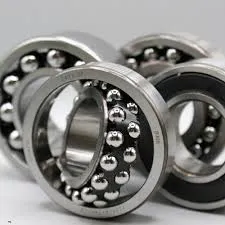
10 月 . 09, 2024 01:30 Back to list
axial ball bearing
Understanding Axial Ball Bearings A Comprehensive Guide
Axial ball bearings are essential components in various mechanical systems, playing a crucial role in how machines operate efficiently. Unlike radial ball bearings, which manage loads perpendicular to the shaft axis, axial ball bearings handle axial loads, which are parallel to the shaft. This specific capability allows them to support heavy loads while facilitating smooth rotation, making them integral in numerous applications, from automotive to aerospace.
What are Axial Ball Bearings?
Axial ball bearings, also known as thrust ball bearings, are designed to handle thrust loads—forces that act along the axis of the bearing. They consist of two grooved rings (raceways) and a ball retainer that holds the balls in place. These components work together to allow smooth rotational movement while providing stability and support against axial forces.
Design and Construction
The design of axial ball bearings is relatively simple yet effective. The basic structure includes
- Inner and Outer Races These are the rings that contain the balls and facilitate their movement. - Balls The rolling elements that reduce friction between the races and support the axial load. - Retainer Also known as a cage, this component keeps the balls spaced evenly, ensuring even load distribution and reducing wear.
The materials used in construction, generally high-carbon chrome steel or ceramic, contribute to durability and performance. The finish and precision of these components are crucial; smooth surfaces minimize friction, leading to improved efficiency and lifespan.
Applications of Axial Ball Bearings
axial ball bearing

Axial ball bearings are utilized in a variety of applications across different industries
. Some common uses include- Industrial Machinery In machines where axial thrust loads are prevalent, such as lathes and milling machines. - Automotive They are used in applications like clutch mechanisms, enabling smooth operation under high loads and varying speeds. - Aerospace In aircraft engines and landing gear systems, axial ball bearings handle significant axial forces while ensuring reliability and safety. - Robotics The precision movement in robotic arms often relies on axial ball bearings to manage thrust loads.
Advantages of Axial Ball Bearings
1. High Load Capacity Axial ball bearings are designed to withstand significant axial loads, making them suitable for heavy-duty applications. 2. Smooth Operation Due to their design, these bearings facilitate smooth movement with minimal friction, ultimately enhancing efficiency. 3. Durability With proper lubrication and maintenance, axial ball bearings can last a long time, reducing the frequency of replacements. 4. Versatility They can be adapted to a wide range of applications across multiple industries, showcasing their flexibility in design and function.
Maintenance and Care
To ensure optimal performance and longevity of axial ball bearings, regular maintenance is crucial. Here are some tips
- Lubrication Utilize the appropriate lubricant to minimize friction. Over or under-lubrication can lead to premature wear. - Regular Inspection Periodic checks for wear and tear or damage ensure that any issues are identified and addressed early. - Proper Alignment Ensure that the bearings are installed correctly, as misalignment can lead to uneven wear and potential failure.
Conclusion
Axial ball bearings are vital components in modern machinery that ensure efficiency and reliability. Their capability to manage axial loads makes them indispensable in various applications, from heavy industries to high-tech environments. Understanding their design, applications, and maintenance can help enhance their functionality and lifespan, providing better performance for your machinery. As technology evolves, axial ball bearings will continue to be a cornerstone in engineering solutions, adapting to meet the demands of future innovations. Whether you're an engineer, technician, or hobbyist, appreciating the intricacies of axial ball bearings will undoubtedly enhance your approach to mechanical design and maintenance.
Latest news
-
Unlocking Efficiency with Spherical Roller Bearings
NewsOct.29,2024
-
The Ultimate Guide to Thrust Ball Bearings
NewsOct.29,2024
-
The Power of Thrust Roller Bearings: Engineered for Excellence
NewsOct.29,2024
-
The Power of Deep Groove Ball Bearings for Your Application Needs!
NewsOct.29,2024
-
The Power and Performance of Cylindrical Roller Bearings
NewsOct.29,2024
-
High-Quality Ball Bearing Manufacturing Machines
NewsOct.29,2024
